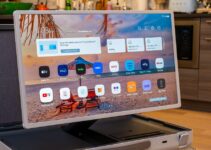This flu season will see at least 26 million cases, 290,000 hospitalizations, and 19,000 deaths, according to the U.S. Centers for Disease Control and Prevention. Pair that with a longstanding physician shortage and it could be a recipe for disaster in ERs and urgent care centers this winter.
One way to alleviate the burden on healthcare workers and potentially improve the patient experience and outcomes is remote patient monitoring. This technology enables doctors and nurses to monitor a patient’s vitals while the patient is in the comfort of their own home – freeing up bedspace in healthcare facilities and removing the stress of a hospital stay.
As president of Honeywell Sensing & Safety Technologies, Sarah Martin knows quite a lot about the opportunities and challenges of RPM. Healthcare IT News sat down with her to discuss how advances in remote monitoring have major benefits in improved care and outcomes, why the ability for healthcare professionals to track vital signs outside a hospital environment becomes important during cold and flu season – and how RPM could be a transformative technology for providers and patients.
Q. How can advances in remote patient monitoring have significant benefits for patients and providers with improved medical care and patient outcomes?
A. RPM has brought about improvements related to clinician efficiency, cost of care and the overall patient experience that have benefited both providers and patient outcomes. One key benefit is the streamlining and simplification of workflows within health systems.
RPM not only reduces the time required for data collection and analysis but minimizes the administrative burden on healthcare professionals. The result is a significant reduction in clinician workloads, freeing up valuable time and resources that can be redirected toward personalized patient care, ultimately leading to enhanced patient outcomes.
In addition to delivering efficient care, the implementation of RPM also proves to be cost-effective. By enabling healthcare providers to monitor and care for patients beyond traditional hospital settings, the technology has the potential to reduce hospital readmissions.
A recent study found that RPM can lead to 87% fewer hospitalizations. This, in turn, frees up beds for those requiring critical in-person attention and contributes to overall cost savings within the healthcare system.
Creating this shift in care delivery not only enhances the overall patient experience but also promotes a more conducive healing environment. Patients can avoid the stress and inconvenience of frequent hospital visits, leading to a substantial improvement to their quality of life.
Additionally, for caretakers, the ability to monitor and manage a patient’s health remotely provides peace of mind that their loved ones are receiving attentive care at home and allows for a more positive and supportive caregiving experience.
Q. Why does the ability for healthcare professionals to remotely monitor vital signs outside a hospital environment become paramount during cold and flu season?
A. Cold and flu season often leads to an influx of patients experiencing respiratory issues and other flu-related symptoms. With RPM, healthcare professionals can keep a close eye on vital signs without requiring patients to visit the hospital frequently.
This not only minimizes exposure of patients to potential infections but also helps efficiently manage resources by reserving in-person visits for those who truly require immediate attention.
During respiratory virus season, the challenges posed by an increased patient load are exacerbated by physician and nurse shortages. As the number of patients admitted increases, so does the need for more doctors, nurses and other healthcare providers.
However, according to the Association of American Medical Colleges, it is projected that there will be a physician shortage of between 37,800 and 124,000 physicians in the U.S. by 2034. By remotely monitoring the vital signs of patients outside the hospital, healthcare professionals can efficiently allocate resources, ensuring they are available for those with severe symptoms while managing less critical cases remotely.
RPM technology provides improved efficiency within clinical settings to navigate the anticipated labor shortage and help maintain a balance in resource utilization during busy times.
Q. How is RPM a transformative technology for both providers and patients? You say it can elevate healthcare accessibility, enhance patient outcomes and improve quality of life. How?
A. We are on the verge of a future where patient-centric tools driven by data are seamlessly integrated into every aspect of patient care delivery. This integration empowers healthcare providers to deliver unparalleled, individualized care while streamlining their workflows.
One of the key transformative aspects of RPM is its ability to revolutionize the way healthcare is delivered by establishing continuous connections with patients and enabling 24/7 monitoring. This proves especially vital for patients with chronic conditions requiring extensive vital sign monitoring over prolonged periods, who cannot stay indefinitely in a hospital setting.
This constant surveillance facilitates early detection of any deviations from baseline health, allowing for timely interventions and preventing the escalation of health issues.
Additionally, RPM provides valuable data for healthcare providers across a wide group of patients, allowing them to see trends in symptoms, treatment and outcomes. Certain limitations on healthcare access such as geography and transportation are reduced by RPM.
The transformative impact on healthcare accessibility is evident as RPM extends care beyond traditional hospital settings, enabling patients to receive personalized attention in the comfort of their homes or in an outpatient setting.
In addition to the medical benefits, the emotional benefits for the patient and their families are significant. From personalized care to an elevated quality of life untethered to a hospital bed create benefits for patients that go beyond medical treatment.
More widespread adoption of RPM technology will be a breakthrough innovation where we can improve healthcare delivery, right-size clinician workloads and achieve better patient outcomes while improving quality of life.
By adopting cutting-edge digital technologies and planning implementation processes properly, we can pave the way for a new era in healthcare.
Follow Bill’s HIT coverage on LinkedIn: Bill Siwicki
Email him: [email protected]
Healthcare IT News is a HIMSS Media publication.


